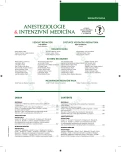Results of ECMO therapy in cohorts of neonates and children
Authors:
V. Vobruba 1; prof. MUDr. Jan Bělohlávek, Ph.D. 2; V. Rohn 4; T. Grus 3; M. Bašková 1; O. Černá 1; J. Fichtl 3; L. Hřídelová 1; J. Hřídel 1; G. Hodková 3; P. Klement 1; D. Lorenčík 1; F. Mlejnský 3; R. Nečasová 1; D. Nikitinský 3; P. Pokorná 1; P. Srnský 1; Z. Švorcová 3; I. Vykydal 3
Authors‘ workplace:
Klinika dětského a dorostového lékařství VFN a 1. LF UK
1; II. interní klinika – klinika kardiologie a angiologie VFN a 1. LF UK
2; II. chirurgická klinika kardiovaskulární chirurgie VFN a 1. LF UK
3; Klinika kardiovaskulární chirurgie 2. LF UK a FN Motol
4
Published in:
Anest. intenziv. Med., 26, 2015, č. 4, s. 213-219
Category:
Intensive Care Medicine - Original Paper
Overview
Objective:
Retrospective evaluation of a sample of 21 neonates and children treated with ECMO.
Design:
Observational, retrospective with prospective data collection.
Setting:
Paediatric and neonatal intensive care unit of a teaching hospital.
Materials and methods:
Between October 2010 and present, extracorporeal membrane oxygenation support was initiated in 21 patients based on meeting the indication criteria (12 neonates, 9 children). According to the etiology and severity of the cardiorespiratory failure, veno-arterial (V-A) ECMO was indicated in 57% of the patients (83% of the neonates, 22% of the children) – the remaining patients were treated with veno-venous (v-V) ECMO.
Results:
The survival rate was 58% in the neonatal group and 77% among the children. This work contains a brief comparison with some results of other international studies. Due to sample size, no statistical evaluation was performed.
Conclusion:
The authors demonstrate on the published sample that provision of the discussed care is neededin the Czech Republic. Many parameters of the presented outcomes are – in spite of the small sample size – comparable with the outcomes of the international registry.
Keywords:
extracorporeal membrane oxygenation – respiratory failure – circulatory failure – neonate – paediatrics
Sources
1. Hill, J. D., Bramson, M. L.,Gerbode, F.,Osborn, J. J., et al. Prolonged Extracorporeal Oxygenation for Acute Posttraumatic Respiratory Failure (Shock-Lung Syndrome) – Use of Bramson Membrane Lung. New England Journal of Medicine,1972, 286, p. 629.
2. Bartlett, R. H., Gazzaniga, A. B., Jefferies, M. R., Huxtab-le, R. F., et al. Extracorporeal Membrane Oxygenation (Ecmo) Cardiopulmonary Support in Infancy. Transactions American Society for Artificial Internal Organs, 1976, 22, p. 80–93.
3. Extracorporeal Life Support Organization: ECLS Registry Report.Ann Arbor, MI, Extracorporeal Life Support organiza-tion 2012.
4. Wernovsky, G., Wypij, D., Jonas, R. A., Mayer, J. E., et al. Postoperative Course and Hemodynamic Profile after the Arterial Switch Operation in Neonates and Infants - a Comparison of Low-Flow Cardiopulmonary Bypass and Circulatory Arrest. Circulation, 1995, 92, p. 2226–2235.
5. Gaies, M. G., Gurney, J. G., Yen, A. H., Napoli, M. L., et al. Vasoactive-inotropic score as a predictor of morbidity and mortality in infants after cardiopulmonary bypass. Pediatric Critical Care Medicine, 2010, 11, p. 234–238.
6. Mugford, M., Elbourne, D., Field, D. Extracorporeal membrane oxygenation for severe respiratory failure in newborn infants. Cochrane Database of Systematic Reviews, 2008.
7. Zabrocki, L. A., Brogan, T. V., Statler, K. D., Poss, W. B., et al. Extracorporeal membrane oxygenation for pediatric respiratory failure: Survival and predictors of mortality. Critical Care Medicine, 2011, 39, p. 364–370.
8. Skinner, S. C., Iocono, J. A., Ballard, H. O., Turner, M. D., et al. Improved survival in venovenous vs venoarterial extracorporeal membrane oxygenation for pediatric noncardiac sepsis patients: a study of the Extracorporeal Life Support Organization registry. Journal of Pediatric Surgery, 2012, 47, p. 63–67.
9. Rehder, K. J., Turner, D. A., Cheifetz, I. M. Extracorporeal Membrane Oxygenation for Neonatal and Pediatric Respiratory Failure: An Evidence-Based Review of the Past Decade (2002–2012). Pediatric Critical Care Medicine, 2013, 14, p. 851–861.
10. Cengiz, P., Seidel, K., Rycus, P. T., Brogan, T. V., et al. Central nervous system complications during pediatric extracorporeal life support: Incidence and risk factors.Critical Care Medicine, 2005, 33, p. 2817–2824.
11. Guner, Y. S., Khemani, R. G., Qureshi, F. G., Wee, C. P., et al.Outcome analysis of neonates with congenital diaphragmatic hernia treated with venovenous vs venoarterial extracorporeal membrane oxygenation. Journal of Pediatric Surgery. 2009, 44, p. 1691–1701.
12. Rollins, M. D., Yoder, B. A., Moore, K. R., Barnhart, D. C., et al.Utility of neuroradiographic imaging in predicting outcomes after neonatal extracorporeal membrane oxygenation. Journal of Pediatric Surgery, 2012, 47, p. 76–80.
13. Brogan, T. V., Zabrocki, L., Thiagarajan, R. R., Rycus, P. T.,et al. Prolonged extracorporeal membrane oxygenation for children with respiratory failure. Pediatric Critical Care Medicine, 2012, 13, E249–E254.
14. Reed, R. C., Rutledge, J. C. Laboratory and Clinical Predictors of Thrombosis and Hemorrhage in 29 Pediatric Extracorporeal Membrane Oxygenation Nonsurvivors. Pediatric and Developmental Pathology, 2010, 13, p. 385–392.
15. Machin, D., Scott, R., Hurst, A. Ground transportation of a pediatric patient on ECMO support. J. Extra Corpor. Technol., 2007, 39, p. 99–102.
16. Coppola, C. P., Tyree, M., Larry, K., Digeronimo, R. A 22-year experience in global transport extracorporeal membrane oxygenation. J. Pediatr. Surg., 2008, 43, p. 46–52, discussion p. 52.
17. Foley, D. S., Pranikoff, T., Younger, J. G., Swaniker, F., et al.A review of 100 patients transported on extracorporeal lifesupport. ASAIO J., 2002, 48, p. 612–619.
Labels
Anaesthesiology, Resuscitation and Inten Intensive Care MedicineArticle was published in
Anaesthesiology and Intensive Care Medicine

2015 Issue 4
Most read in this issue
- Vasopressin and its role in anaesthesiology and intensive care medicine
- Echocardiography for cardiac output assessment in critically ill patients
- Peri-operative management of the obese surgical patient 2015
- Results of ECMO therapy in cohorts of neonates and children
